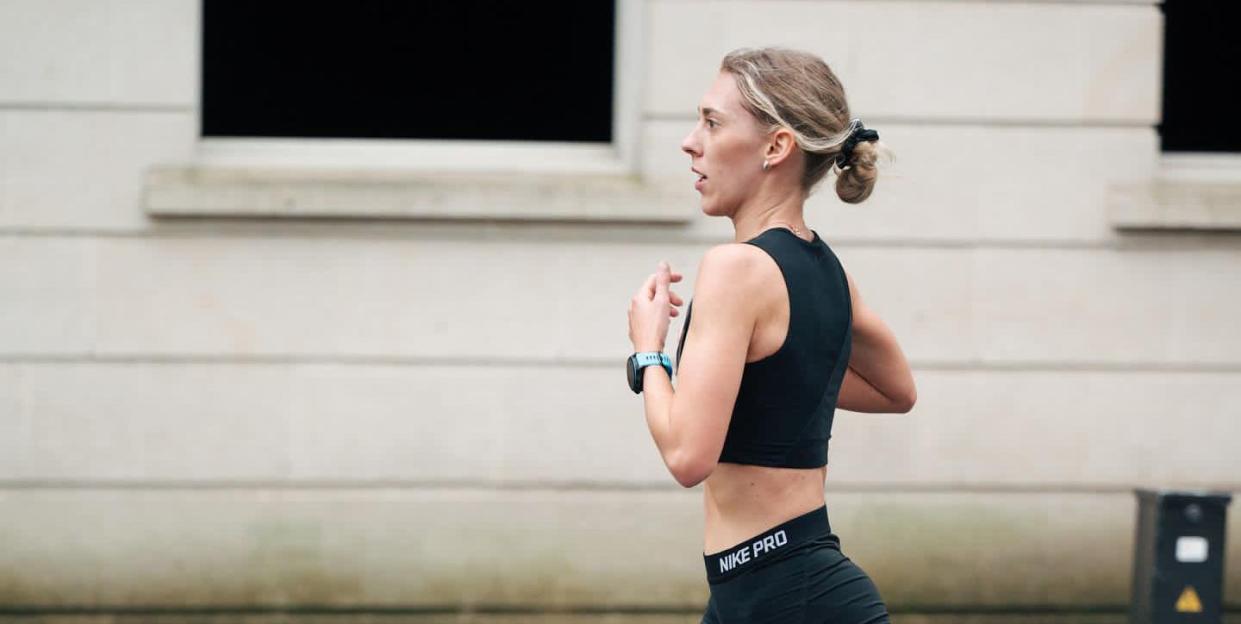We chatted to Charlie Arnell about the training that earned her the win at the Manchester Marathon

Not many people can say they won their debut marathon. But Charlie Arnell is not most people. Making her marathon debut in Manchester on Sunday 14 April, Arnell was the first woman through the finish line, clocking an impressive 2:37:12.
The MK Distance Project runner finished almost five minutes clear of Melissah Gibson from Ealing Eagles Running Club, who came in second with a time of 2:42:09.
Even more impressively, Arnell won the UK’s second largest marathon alongside working full-time for the NHS clinical systems team.
How did Arnell win her debut marathon?
Encouraged by her father to join an athletics club, Arnell began running at nine years old. She’s ‘stopped and started’ running her entire life and, upon leaving uni where she trained to become a nurse, decided to give running ‘another good shot’ as a senior. Repeated knee injuries led her to surgery in 2021, at which point she didn’t think she’d ever be able to do a half marathon again, never mind run – and win – a full marathon. But she said she was ‘amazed’ by the outcome of her surgery and got back to her running goals. She’s had one aim on her mind the past three years and that’s been to get a full marathon under her belt, even if it meant getting injured again. Luckily, she said: ‘I’ve not had any niggles. So, the plan is to keep going now.’
With her sights set on the Manchester Marathon, the 30-year-old runner began training with a new coach, Gavin Pavey, in January.
Before January, Arnell ran about 70km (43 miles) a week and usually for no longer than 75 to 90 minutes at one time. Once she joined Pavey, still cautious of injury, she upped the distance to 100km a week. However, she fell ill within the 12-week training block, so averaged about 90km over six days each week. Throughout the block, Arnell always had a rest day on a Monday, completed a track session on a Tuesday working on speed at VO2 max, a tempo session on a Friday based on marathon pace [in her case, a speedy 3:40min/km] and a long run on a Sunday.
Arnell’s tempo session would look something like three 5K efforts with a two-minute jog recovery in between. Her Sunday long runs were different to how they were pre-January as she upped them from about 90 minutes to two and a half hours. She explained that she would focus on duration rather than distance for these runs, ‘But it’s not just about time on your feet,’ she said. ‘It’s really important to run at marathon pace too.’ As such, she found a particular training method, taught to her by Pavey, useful and this was adding in a 45-minute segment at marathon pace during her long run. ‘It was completely new for me, and it was hard – probably one of my toughest sessions,’ she said. But it was clearly worth it. She also added one double run day into her week and will probably up this now considering the training went so well and she has completed the block injury-free.
Staying on top of her strength and conditioning training, especially to improve the strength of her knee, Arnell incorporates two S&C sessions into her weekly schedule. She explained that one session involves heavy lifting focussing on lower body exercises such as squats, Romanian deadlifts and Bulgarian split squats; and the other would be lighter with band work, mobility movements, stretching and foam rolling.
That’s a lot of training on top of a full-time job, so how does Arnell rest and recover in between? She said she tries to stretch regularly, eat properly, stay hydrated and enjoys going in her jacuzzi.
With the help of her coach, Arnell had a personalised nutrition strategy leading up to the marathon. She struggles to eat breakfast before a race so aimed to eat 500 grams of carbs for each of the two days before the race to make sure she had enough fuel in the tank to get her around the course.
The big day
Arnell felt comfortable, and looked impressively fresh, throughout the entire race at Manchester. She said she felt her strongest between 25km-35km. At 35km she noticed her pace slowing down and put this down to her legs getting tired – hardly surprising at this point of a marathon,
As for which shoes she was wearing? A fresh pair of Nike Vaporfly 3. In addition to this, Arnell does her easy runs in Hoka Clifton 9 and track and tempo sessions in her Vaporflys.
A word of advice
When asked what advice she would offer those taking on their first marathon, the Manchester winner highlighted how racing is just as much a mental challenge as it is a physical one. ‘Just stick at it. Running is such a mental game,’ she said.
‘I think it's important to have your own personal goals that will help motivate you on those days when it's raining, wet and cold, and you don't want to go out,’ she added. We all know what those days are like, but having a reason to step out the door certainly helps.
After resting up this week, the British runner will speak to her coach about what’s next. But she sees an autumn marathon on the cards. Besides trying to get her 10K and half marathon times down, her current goal is to get as close to 02:30:00 as possible for the marathon. Following that, she said: ‘I'd love to get an England vest. And then hopefully one day, the dream would be to have a GB vest.’
You Might Also Like


